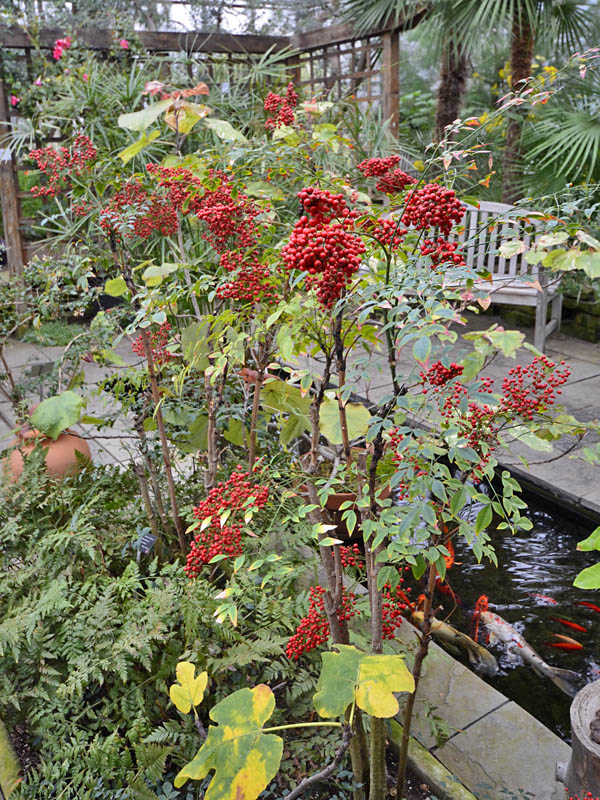
Woody > Nandina > Nandina domestica > Nandina domestica
Nandina domestica
Sacred Bamboo
Origin: Native to India, China, and Japan.
Mike's
Opinion


"
While many cultivars of Sacred Bamboo are great for use in a variety of locations, the straight species has little to offer to any landscape unless frequently maintained. It can be used as an informal hedge but is easily spread by birds and has been classified as an invasive species in the southern United States of America. Even with the winter interest this plant offers I wouldn’t recommend it with so many fine cultivars to take its place, such as N. domestica 'Richmond'.
Michael Pascoe, NDP., ODH., CLT., MSc. (Plant Conservation)
"
| Family |
| Berberidaceae |
| Genus |
| Nandina |
| Species |
| domestica |
| Category |
| Woody |
| Type |
| Shrub (evergreen) |
| USDA Hardiness Zone |
| 6 - 9 |
| Canadian Hardiness Zone |
| 5a - Requires cool season protection under glass. |
| RHS Hardiness Zone |
| H3 - H7 |
| Temperature (°C) |
| -23 -(-1) |
| Temperature (°F) |
| -10 - 30 |
| Height |
| 1 - 2.5 m |
| Spread |
| 0.5 - 1.5 m |
Photographs
Description and Growing Information
Flowering Period
| General Description |
| Sacred Bamboo is an evergreen shrub with multiple stems covered with glossy bi- to tri-pinnately compound leaves which change colour from green in summer to bright red in winter; foliage is accompanied by red berries. |
| Landscape |
| Sacred Bamboo has a wide variety of landscape uses, from foundations to hedges. Uniformity can be hard to achieve in plants grown from seed and can result in a mixed texture when planted 'en masse'. |
| Cultivation |
| It grows well in moist, well-drained, rich loamy soils. Best growth occurs in full sun and is drought tolerant however, can tolerate shade in hotter regions. |
| Shape |
| Upright weeping shrub. |
| Growth |
| Medium |
| ID Characteristic |
| Pinnately compound leaves with two or three leaflets, on thin medium to fine textured stems with yellow wood characteristic of the Berberidaceae family. In winter, the leaves are bright red. |
| Pests |
| No notable pests, but may be susceptible to Nandina Mosaic which causes mottled colouring on the leaves. |
| Habitat |
| Sacred Bamboo grows in the moist woodlands, ravines and valleys in the mountains and warmer regions of Eastern Asia and Japan. |
| Bark/Stem Description |
| The bark is reddish in colour when young and matures to a light brown, its texture is medium to fine. |
| Flower/Leaf Bud Description |
| The buds are pinkish, 1 - 2 mm and nondescript. They are hidden by the ensheathing base of the petiole and are only visible after removing the leaf. |
| Leaf Description |
| Sacred Bamboo has broadleaf, evergreen foliage, emerging as alternate bi- to tri-pinnately elliptic-lanceolate compound leaves, 30-90 cm long. Glabrous leaves emerge pinkish and bronzy red and turn a metallic bluish green, becoming hues of red in winter. |
| Flower Description |
| The perfect white flowers are found on erect panicles 15 - 30 cm long in early summer, blooms are 5 - 10 mm and have between 3 - 6 petals. |
| Fruit Description |
| The fruit of Sacred Bamboo is borne in panicles of bright red berries 6 - 8 mm across, persistent from autumn to winter; each berry contains 1 - 3 seeds. |
| Colour Description |
| Sacred Bamboo foliage is metallic bluish-green changing to bright shades of red in autumn and winter. The bark is reddish and matures to a light brown colour. White flowers and small red berries. |
| Texture Description |
| Texture can be fine if the plant is kept pruned, otherwise it is a medium textured plant. |
| Notable Specimens |
| Queens Botanical Garden, Flushing, New York, United States of America. |
| Propagation |
| Sow seeds as soon as possible as they have very poor germination rates. The seed can be germinated by cold stratification or with cold, moist pre-chilling. Division is more common when reproducing a unique specimen for further development and can be accomplished by cutting the root ball in spring. Cuttings can be taken from semi-hardwood or hardwood, between 10-15 cm and rooted in a well-drained media. |
References
G.S., Thomas. "Shrubs. Ornamental Shrubs, Climbers and Bamboos". Portland, Oregon: Sagapress/Timber, 1992. 286. Print.
Dirr, Michael. "Manual of Woody Landscape Plants": Their Identification, Ornamental Characteristics, Culture, Propagation and Uses. Champaign, IL: Stipes Pub., 2009. 760-61. Print.
